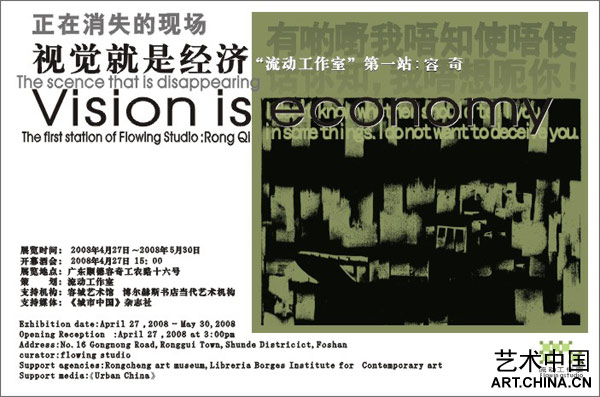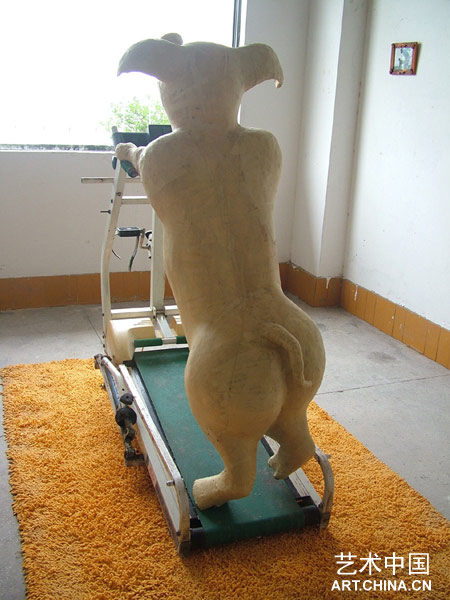
正在消失的現場
“流動的工作室”的第一站:容奇
項目
“正在消失的現場”是流動工作室自發策劃的一個長期持續的展覽活動項目,所謂“流動”就是工作室的空間將會不定期地轉移,它的所在地就是那些失效的或過期,將會被拆掉的建築空間,所以,展覽活動的地點會不斷變化。
活動的目的是通過這樣流動的過程來考查一些非中心地區的、微觀的經濟文化生態,挖掘一些隱秘的民間野史個案,為活動提供更多社會學和地質學意義上的素材。以當代藝術實踐發生的“空間轉換”來改變藝術實踐的方式作為一個重要的前提,也涉及與之前固有的當代藝術實踐方式和展示空間的應對。相信存在這樣的可能:空間的轉換會帶來角度的更新和狀態的提升,同時能通過在這些空間裏的一系列藝術實踐活動及特殊的方式來介入或投射社會現實的某些問題,用活動本身來對應現實的問題情境,這是一個主要的出發點。同時,我們也希望通過這樣的活動將當代藝術的能量延伸到基層的地帶,讓當代藝術與更多的非中心地帶發生關係。
我們將對空間進行具體的分析、了解和評估,在實踐成本上進行仔細的考量和規劃。然後確定活動的詳細計劃,邀請不同領域的藝術家、學者和文化工作者參與,在某一空間展覽活動次數不定。現場展示內容包括:錄影、裝置、文獻、攝影、繪畫、紀錄片。
The scence that is disappearing .
The First Station of “Flowing Studio”: Rongqi
project
“The site that is disappearing or changing” is a long-term continuous project of exhibition activities planned spontaneously by Flowing Studio. The so-called “Flowing” means that the space of the Studio will transfer irregularly, with the location being the expired or aging architectural space to be demolished, so the place of exhibition activities will continue to change.
The purpose of such activities is to investigate the microeconomic and cultural ecology in some non-central regions, to explore some secret individual cases about unofficial folk history, and thus provide more sociological and geological source materials for the activities. Using “space conversion” of contemporary art practice to change the art practice way is considered as an important precondition, it also involves the response to the intrinsic contemporary art practice way and exhibition space. We believe in the following possibility: the space conversion will result in the renewal of visual angle and upgrade of status, and meanwhile a series of art practice activities in these spaces and the special practice ways can be used to intervene or reflect some realistic problems in the society. Using the activities to reflect the realistic problems is a major starting point. Meanwhile, we also hope that such activities can spread the energy of contemporary arts into grass-roots areas, and make the contemporary arts associated with more non-central regions.
We’ll analyze, understand and evaluate the space in details, consider and plan carefully about the practice cost, then determine on specific plans for activities, and invite artists, scholars and cultural workers to participate in the activities. The number of exhibition activities within certain space is indefinite. The on-site exhibition includes: videos, devices, literatures, photographs, paintings and documentary films.
空間
容奇工作室所在地的背景資料:
容奇工作室位於順德容奇工農路十六號,原為容奇米廠。周圍順德德勝河大堤外約200米的範圍內,有大大小小數十家老廠房。這些廠房大都建於上世紀50年代的“大躍進”時期,其中包括著名的順德繅絲機械配件廠、桂洲石灰廠、容奇米廠、順德冰廠等,形成早期順德的老工業區。有些廠房甚至是解放前所建,多在2000年前後或倒閉或轉産。由於位處省一級水源保護區,政府已下發搬遷令,這些曾經代表著順德工業輝煌時期的老廠房再近年內都將被拆除。
Background Information about Site of Rongqi Studio:
Located at No.16 Gongnong Road, Rongqi, Shunde, Rongqi Studio was once Rongqi Rice Mill formerly. There are dozens of old workshops in the range of approximately 200 meters surrounding Shunde Desheng River Dam. These workshops were mostly built in the period of “Great Leap Forward” in 1950’s, including Shunde Filature Machine Component Plant, Guizhou Lime Plant, Rongqi Rice Mill and Shunde Ice Mill, which constituted the old industrial area of Shunde in early days. Some of those workshops were even built before liberation and mostly either wound up or changed the line of production around 2000. Due to the location in the provincial-level water source reservation, the government has issued the order of move and these old workshops that once represented the splendid era of Shunde industry will be demolished in recent years.
藝術活動
“流動工作室”容奇站活動之一:“視覺就是經濟” 藝術活動
“視覺就是經濟”應是一個具有審視性質的判斷。
“視覺”在這裡不單單是生理的功能,更重要的是“視覺”如何變成一個社會生活系統中重要仲介者——它成為思考的一個主要素材來源,對大部分人來説,這就是他們日常生活的重要構成部分。不斷製造出來視覺傳播載體及資訊擴充個體的認知界面,同時也造成了不同程度的認知干擾。
“視覺”在社會的政治經濟活動中充當了不可缺少的作用,“視覺”要變成成品就必然需要成本,它被設計,被製作,出版,變成視覺成品,形成大批量極具侵略性和誘惑性的符號,通過傳播系統將圖像、影像、物品迅速散發、輻射,影響力和繁殖力驚人。這是一個視覺符號過剩的時代,一切社會經濟生産運作的關係都這些表面的符號所暗示和引證。
城市有城市的視覺系統,鄉鎮有鄉鎮的視覺系統,農村有農村的視覺系統,這是一種政治經濟活躍程度的等級化體現。當然這是一個很正常的視覺分配。
作為視覺成品的藝術品是特殊的終端産品。它的産生來源於藝術生産者的精神成本及資金成本,藝術生産者通過複雜的心智、體驗、靈感的融合與投入,同時也將社會的文化現實作為某種內在的參照,在一個整體考量的基礎上,作品的生産就有了充分的條件。
實際上,大部分藝術品的生産會對應一種特定的社會政治經濟的語境,它們對特定的現實狀態作出反應也從這種特定狀態中産生。
Exhibition and activities
The first activity at “Flowing Studio” Rongqi Station: “Vision is economy”
“Vision is economy” should be a judgment of perspective nature.
“Vision” does not merely refer to physiological function, but more importantly how to change “vision” into an important medium in social life system, which has become a major source material for thinking. For most people, this is an important component for their daily life, i.e. to create continuously the cognition interface of visual communication carriers and information extension units, but meanwhile it results in cognitive disturbance of different levels.
“Vision” plays an indispensable role in social political and economic activities. To change “vision” into finished products naturally needs cost. Once designed, manufactured and published, it changes into finished visual products, and forms into a large number of aggressive and seductive visual symbols. Images and pictures, videos and articles are distributed and spread rapidly via the transmission system, with an amazing influence and reproduction potential. This is an era of superfluous visual symbols, since all the social economic production and operation relations are implied and adduced by these superficial symbols.
Cities have their own visual system, and towns and rural areas have their own systems too. This is a kind of hierarchical embodiment of political and economic dynamic levels. Naturally, this is also a normal visual distribution.
The artworks as the finished visual products are special terminal products. Its origin comes from the psychic cost and financing cost of the artists, who integrate and utilize their complicated thinking, experience and inspirations, and meanwhile consider comprehensively the refer to the conditions about social and cultural reality, and thus obtain substantial conditions for artwork creation.
In fact, the creation of most artworks corresponds to a special kind of social, political and economic context. Such artworks respond to the specific realist situation and meanwhile originate from such situation.
(排名不分先後)
藝術家:周滔 劉慶元 黃小鵬 羅 靈(水木堂工作室) 朱曄 樊哲 楊美艷+吳海燕 劉可 喻旭東 張嘉平 陳明生 梁健華 謝劍波 第五工作室
邀請文化工作者:
陳侗 馮原 楊小彥 吳國霖 胡昉 姜珺 蔡濤 胡斌 王梆
支援機構:容城藝術館 博爾赫斯書店藝術機構
支援媒體:《城市中國》雜誌社
活動時間:2008年4月27日——2008年5月30日
活動地點:順德容奇工農路十六號
Artists: ZHOU Tao HUANG Xiaopeng LIU Qingyuan ZHU Ye LUO Ling (ShuimutangStudio) FAN Zhe YANG Meiyan WU Haiyan CHEN Mingsheng YU Xudong ZHANG Jiaping LIU Ke LIANG Jianhua XIE Jianbo
Scholars to be invited:
CHEN Tong FENG Yuan WU Guolin HU Fang JIANG Jun CAI Tao HU Bin WANG Bang
Supporting Agency: Rongcheng Museum of Art Libreria Borges Institute for Contemporary Art
Supporting Media: Urban China
Time: March 22, 2008—May 30,2008
Place: No.16 Gongnong Road, Rongqi, Shunde

部分參展藝術家集體照

陳明生 一線江景
|

